Study on Asymmetric Failure and Control Measures of Lining in Deep Large Section Chamber
Abstract
:1. Introduction
2. Engineering Background
2.1. Engineering and Geology Background
2.2. Field Failure Analysis
3. Asymmetric Mechanical Model and Evaluation Index
3.1. Asymmetric Mechanical Model
3.2. Analysis Scheme
3.3. Evaluation Indexes
- bending moment change ratio
- bending moment balance ratio
- displacement change ratio
- displacement balance ratiowhere, —In the xn scheme, the sum of absolute values of crown bending moments on both left and right sides at y distance from the arch bottom. —In the xn scheme, the bending moment value at y position of the left. In the xn scheme, the sum displacement of lining on both left and right sides is at y distance from the arch bottom. In the xn scheme, the displacement value of the right arch body is from the y position of the arch bottom. Where x is A~C, representing three types of schemes respectively; n is 2~7, representing 2~7 schemes respectively; y is the distance to the arch foot; l and r represent the left and right respectively.
4. Analysis of Asymmetric Mechanical Behavior of Lining
4.1. Asymmetric Coefficient
4.1.1. Bending Moment Analysis
4.1.2. Displacement Analysis
4.2. Section Size
4.2.1. Bending Moment Analysis
4.2.2. Displacement Analysis
4.3. Lining Thickness
4.4. Summary and Engineering Recommendations
5. Control Measures and Application Effect
5.1. Control Measures
- ①
- After optimization, the net section width of the pump house is 5000 mm and the height is 7200 mm, which avoids the expansion of the lining and reduces the surrounding rock disturbance.
- ②
- The west straight wall and west arch shoulder of the pumping house adopt the Φ29 × 12,000 mm grouting anchor cable, and the other side adopts the Φ29 × 10,000 mm grouting anchor cable. The bottom arch adopts the Φ29 × 8000 mm grouting anchor cables. The diameter of the anchor hole is 38 mm, and two MSZ2870 resin cartridges are used. The cartridges can be cured after being stirred evenly for 5 min. After the end of grouting anchor cable is anchored, 150 kN preload is applied first, and then grouting is carried out one by one to reinforce the broken surrounding rock.
- ③
- On the outside of the existing section, double-layer reinforcement is bound on the whole section, with the diameter of transverse reinforcement of 28 mm and longitudinal reinforcement of 32 mm. C40 concrete is used for pouring, and the lining thickness is 500 mm.
5.2. Application Effect
6. Conclusions
- (1)
- Aiming at the asymmetric failure of lining in Wanfu Coal Mine pump house due to the secondary disturbance, the asymmetric mechanical model of the lining and the quantitative evaluation indexes such as the change rate of bending moment, the balance rate of bending moment, the change rate of displacement and the balance rate of displacement are established, and the influence laws of the asymmetric coefficient, the section size and the thickness on the bending moment and displacement of the lining are studied.
- (2)
- Under the action of asymmetric load, the bending moment and displacement of lining shows an obvious asymmetry. The larger the asymmetry coefficient is, the more significant the increase of bending moment and displacement will be. The larger the section size is, the more obvious the influence of the asymmetric load is. Increasing the lining thickness is beneficial to improve the lining resistance to the asymmetric load, when the lining thickness exceeds a certain value, the effect of increasing the lining thickness is no longer obvious.
- (3)
- The control measures with the core of “strengthening asymmetric support, reducing section size, improving lining strength” is proposed. The field application shows that the method can effectively restrain the asymmetric deformation of the surrounding rock, and the maximum deformation is only 7.3 mm, which ensures the long-term stability of the chamber. It has an important guiding significance for engineering under similar conditions.
Author Contributions
Funding
Institutional Review Board Statement
Informed Consent Statement
Data Availability Statement
Acknowledgments
Conflicts of Interest
References
- He, M.C.; Wang, Q.; Wu, Q.Y. Innovation and future of mining rock mechanics. J. Rock Mech. Geo Eng. 2021, 13, 1–21. [Google Scholar] [CrossRef]
- Xie, H.P. Research review of the state key research development program of China: Deep rock mechanics and mining theory. J. China Coal Soc. 2019, 44, 1283–1305. [Google Scholar]
- Wang, Q.; Gao, H.K.; Jiang, B.; Li, S.C.; He, M.C.; Qin, Q. In-situ test and bolt-grouting design evaluation method of underground engineering based on digital drilling. Int. J. Rock Mech Min. Sci. 2021, 138, 104575. [Google Scholar] [CrossRef]
- Wang, L.G.; Lu, Y.L.; Huang, Y.G.L.; Sun, H.Y. Deep-shallow coupled bolt-grouting support technology for soft rock roadway in deep mine. J. China Univ. Min. Technol. 2016, 45, 11–18. [Google Scholar]
- Li, S.C.; Shao, X.; Jiang, B.; Wang, Q.; Wang, F.Q.; Ren, Y.X.; Wang, D.C.; Ding, L.G. Study of the mechanical characteristics and influencing factors of concrete arch confined by square steel set in deep roadways. J. China Univ. Min. Technol. 2015, 44, 400–408. [Google Scholar]
- Sun, H.B.; Li, S.C.; Wang, Q.; Zhou, L.S.; Jiang, B.; Zhang, X.; Xu, S.; Zhang, H.J. Research and Application of Fabricaed Confined Concrete Construction System for Large Cross Section. Tunn. Undergr. Space Technol. 2018, 31, 320–327. [Google Scholar]
- Wang, Q.; Xin, Z.X.; Jiang, B.; Sun, H.B.; Xiao, Y.C.; Bian, W.H.; Li, L.N. Comparative experimental study on mechanical mechanism of combined arches in large section tunnels. Tunn. Undergr. Space Technol. 2020, 99, 103386. [Google Scholar] [CrossRef]
- Guo, J.; Feng, G.R.; Wang, P.F.; Qi, T.Y.; Zhang, X.R.; Yan, Y.G. Roof Strata Behavior and Support Resistance Determination for Ultra-Thick Longwall Top Coal Caving Panel: A Case Study of the Tashan Coal Mine. Energies 2018, 11, 1041. [Google Scholar] [CrossRef] [Green Version]
- Wang, Q.; Xu, S.; Jiang, B.; Li, S.C.; Xiao, Y.C.; Xin, Z.X.; Liu, B.H. Research progress of confined concrete support theory and technology for underground engineering. J. China Coal Soc. 2020, 45, 2760–2776. [Google Scholar]
- Xu, Y.; Bo, J.B.; Wu, Z.R.; Feng, J.S. Instability Mechanism and Reinforcement Technology of Brickwork Roadway. J. Min. Saf. Eng. 2012, 29, 790–796. [Google Scholar]
- Huang, Y.B.; WANG, Q.; Gao, H.K.; Jiang, Z.H.; Li, S.; Chen, K. Failure mechanism and construction process optimization of deep soft rock chamber group. J. China Univ. Min. Technol. 2021, 50, 69–78. [Google Scholar]
- Sun, K.G.; Li, S.C.; Zhang, Q.S.; Li, S.C.; Li, J.L.; Liu, B. Study on monitoring and simulation of super-long mountain tunnel lining. Chin. J. Rock Mech. Eng. 2007, 26, 4465–4470. [Google Scholar]
- Wang, Q.; Jiang, Z.H.; Jiang, B.; Gao, H.K.; Huang, Y.B.; Zhang, P. Research on an automatic roadway formation method in deep mining areas by roof cutting with high-strength bolt-grouting. Int. J. Rock Mech. Min. Sci. 2020, 128, 104264. [Google Scholar] [CrossRef]
- Wang, Q.; He, M.C.; Jiang, B.; Li, S.C.; Jiang, Z.H.; Wang, Y.J.; Xu, S. Experimental research and application of automatically formed roadway without advance tunneling. Tunn. Undergr. Space Technol. 2021, 114, 103999. [Google Scholar] [CrossRef]
- Ghosh, G.K.; Sivakumar, C. Application of underground microseismic monitoring for ground failure and secure longwall coal mining operation: A case study in an Indian mine. J. Appl. Geophys. 2018, 150, 21–39. [Google Scholar] [CrossRef]
- Saeedi, G.; Shahriar, K.; Rezai, B.; Karpuz, C. Numerical modelling of out-of-seam dilution in longwall retreat mining. Int. J. Rock Mech. Min. Sci. 2010, 47, 533–543. [Google Scholar] [CrossRef]
- Rezaei, M.; Hossaini, M.F.; Majdi, A. Development of a time-dependent energy model to calculate the mining-induced stress over gates and pillars. J. Rock Mech. Geotech. Eng. 2015, 7, 306–317. [Google Scholar] [CrossRef]
- Zhai, X.X.; Huang, G.S.; Chen, C.Y.; Li, R.B. Combined Supporting Technology with Bolt-Grouting and Floor Pressure-Relief for Deep Chamber: An Underground Coal Mine Case Study. Energies 2018, 11, 67. [Google Scholar] [CrossRef] [Green Version]
- Waldemar, K.; Krzysztof, S.; Łukasz, H. Metody badania obudowy kotwowej w Katedrze Górnictwa Podziemnego AGH. Cuprum 2015, 3, 49–60. [Google Scholar]
- Wang, Q.; Qin, Q.; Jiang, B.; Xu, S.; Zeng, Z.N.; Luan, Y.C.; Liu, B.H.; Zhang, H.J. Mechanized construction of fabricated arches for large-diameter tunnels. Automat. Constr. 2021, 124, 103583. [Google Scholar] [CrossRef]
- Chang, B.L.; Li, J.B.; Xu, Y. Instability mechanism and control technology of Surrounding rock of brickwork roadway. Saf. Coal Min. 2015, 46, 100–103. [Google Scholar]
- Zhao, M.Z.; Meng, W.F.; Lu, D.H.; Huang, C.F. Damage of upper arch walling support roadway with lower working face mined. J. Min. Saf. Eng. 2011, 36, 23–27. [Google Scholar]
- Wang, Q.; He, M.C.; Xu, S. Mechanical properties and engineering application of bolt made of new constant resistance energy absorbing materials. J. China Coal Soc. 2021. [Google Scholar] [CrossRef]
- Liu, Q.S.; Shi, K.; Kang, Y.S.; Huang, X. Monitoring analysis of secondary lining structure of central pump house in deep coal mine. Chin. J. Rock Mech. Eng. 2011, 30, 1596–1603. [Google Scholar]
- Skrzypkowski, K. Case Studies of Rock Bolt Support Loads and Rock Mass Monitoring for the Room and Pillar Method in the Legnica-Gogów Copper District in Poland. Energies 2020, 13, 2998. [Google Scholar] [CrossRef]
- Jing, S.G.; Su, Z.L.; Wang, X.K. Research and application on the coupling mechanism of cable and masonry for chamber with large-section. J. Min. Saf. Eng. 2018, 35, 1158–1163. [Google Scholar]
- Wang, S.H.; Wang, P.Y.; Liu, Y.; Zhu, B.Q. Experimental Study on failure mode of tunnel model containing cavity in different locations. J. Northeast. Univ. 2020, 41, 863–869. [Google Scholar]
- Sun, X.M.; Zhang, G.F.; Cai, F.; Yu, S.B. Asymmetric deformation mechanism within inclined rock strata induced by excavation in deep roadway and its con-trolling countermeasures. J. Rock Mech. Eng. 2009, 28, 1137–1143. [Google Scholar]
- Wang, J.; Guo, Z.B.; Cai, F.; Hao, Y.X.; Liu, X. Study on the asymmetric deformation mechanism and control countermeasures of deep layers roadway. J. Min. Saf. Eng. 2014, 31, 28–31. [Google Scholar]
- Long, Y.Q.; Bao, S.H. Course of Structural Mechanics; Higher Education Press: Beijing, China, 2001; pp. 79–91. [Google Scholar]
- Fan, Z.; Shi, S.; Li, Z.B.; Wang, Q.Q.; Zhao, C.J.; Kou, L.; Shi, J.W. Research on large diameter concrete filled tubular column and H-section beam connection. J. Build. Struct. 2016, 37, 1–12. [Google Scholar]
- Zhu, W.S.; He, M.C. Stability and Dynamic Construction Mechanics of Surrounding Rock under Complex Condition; Beijing Science Press: Beijing, China, 1995; pp. 155–182. [Google Scholar]
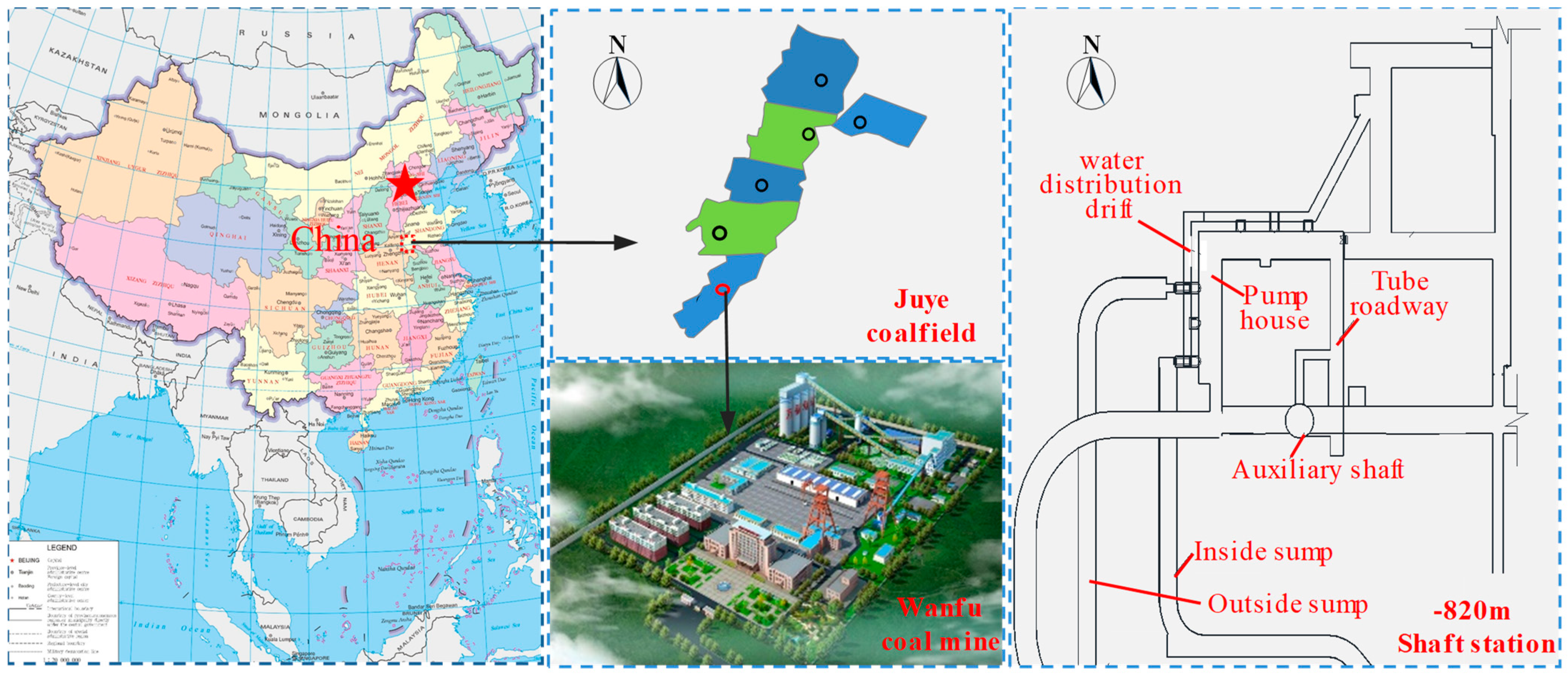
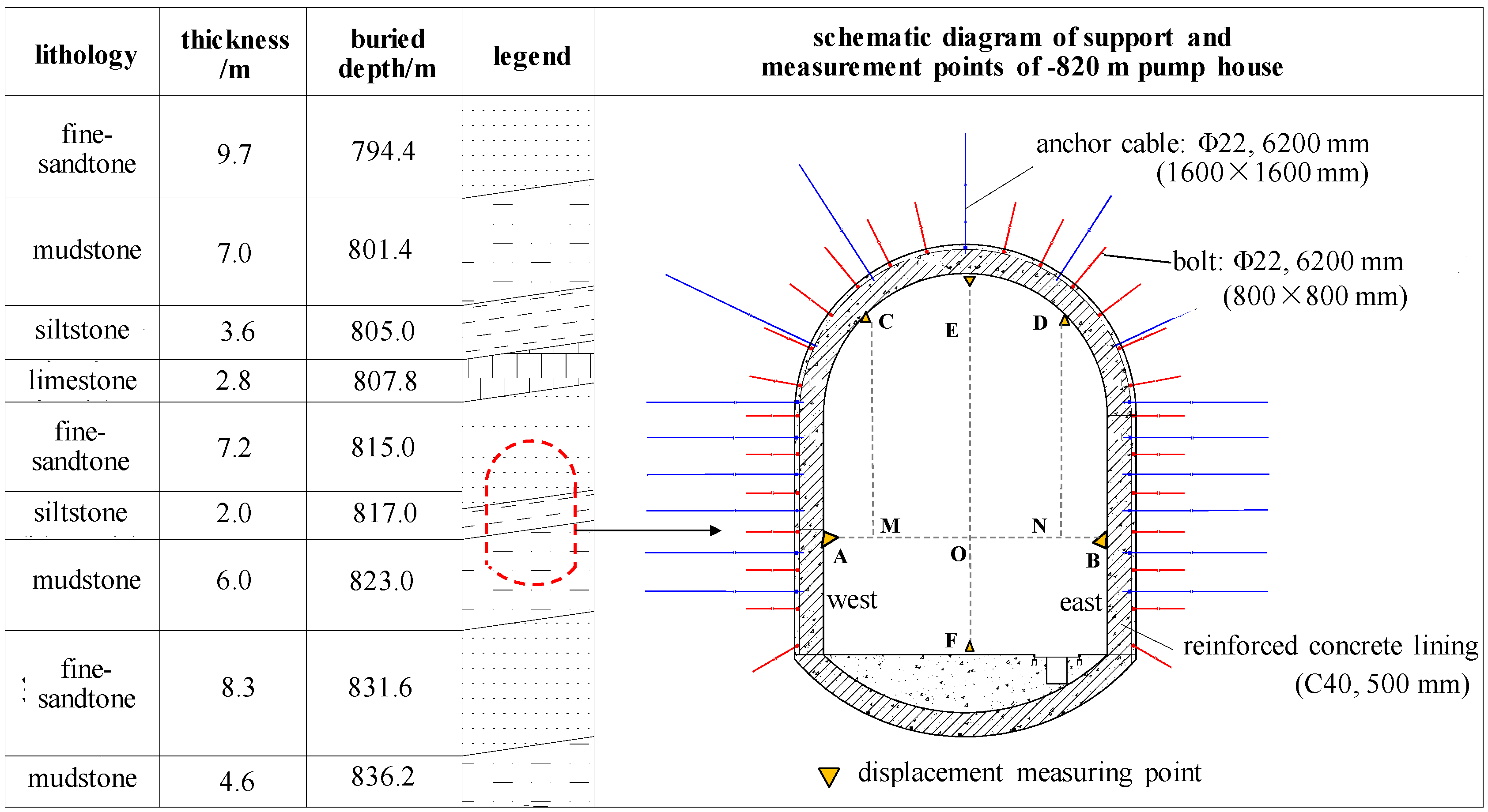
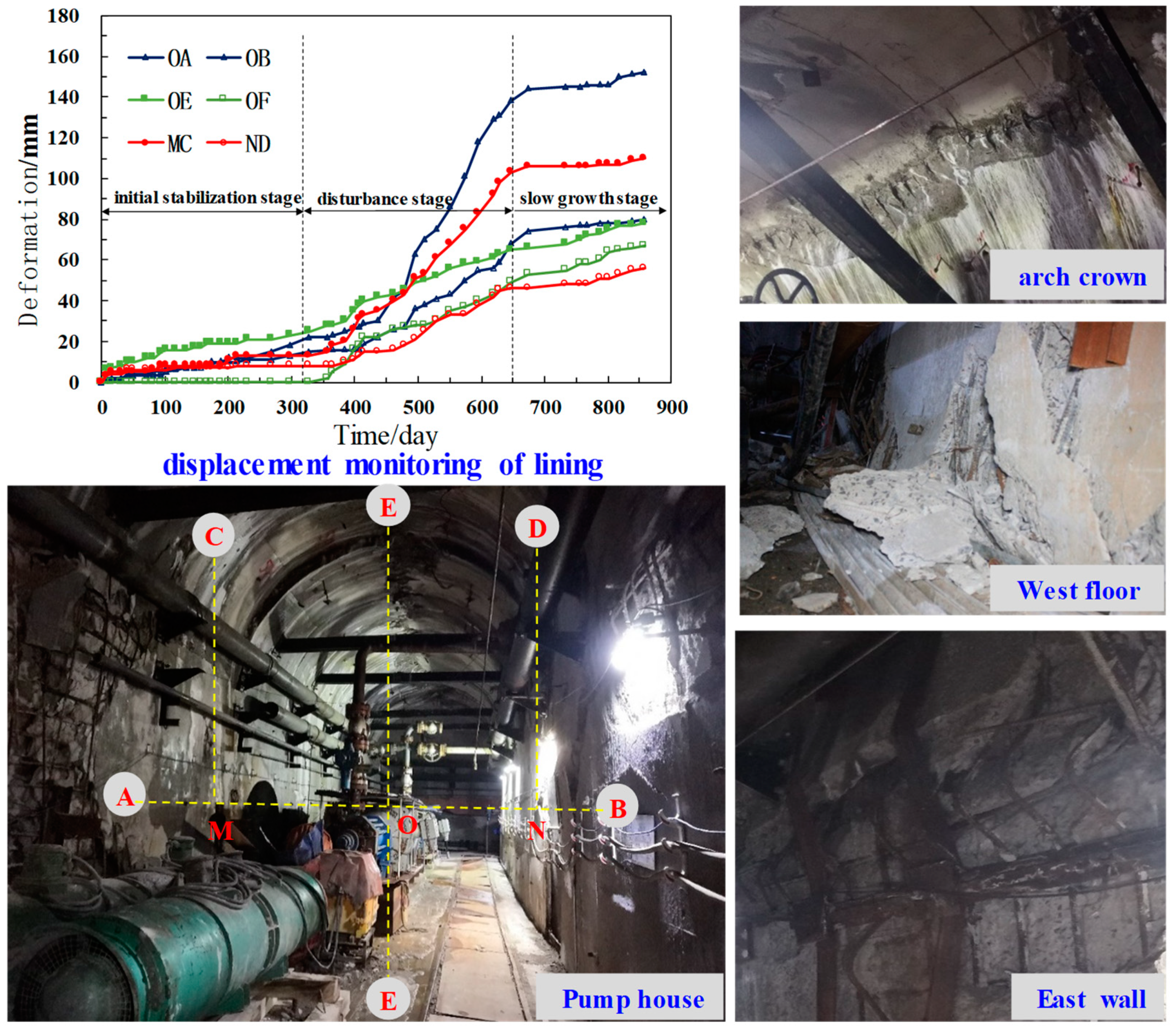

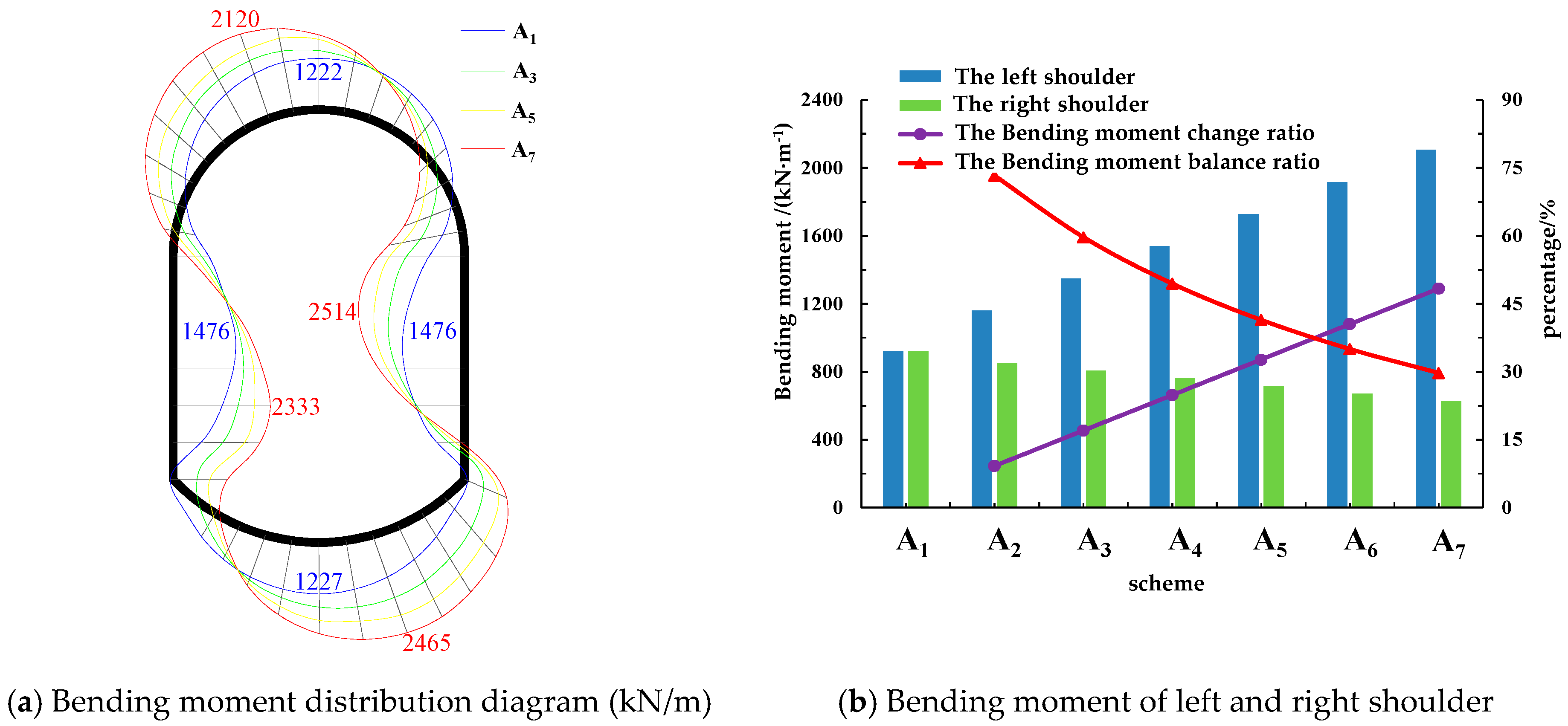
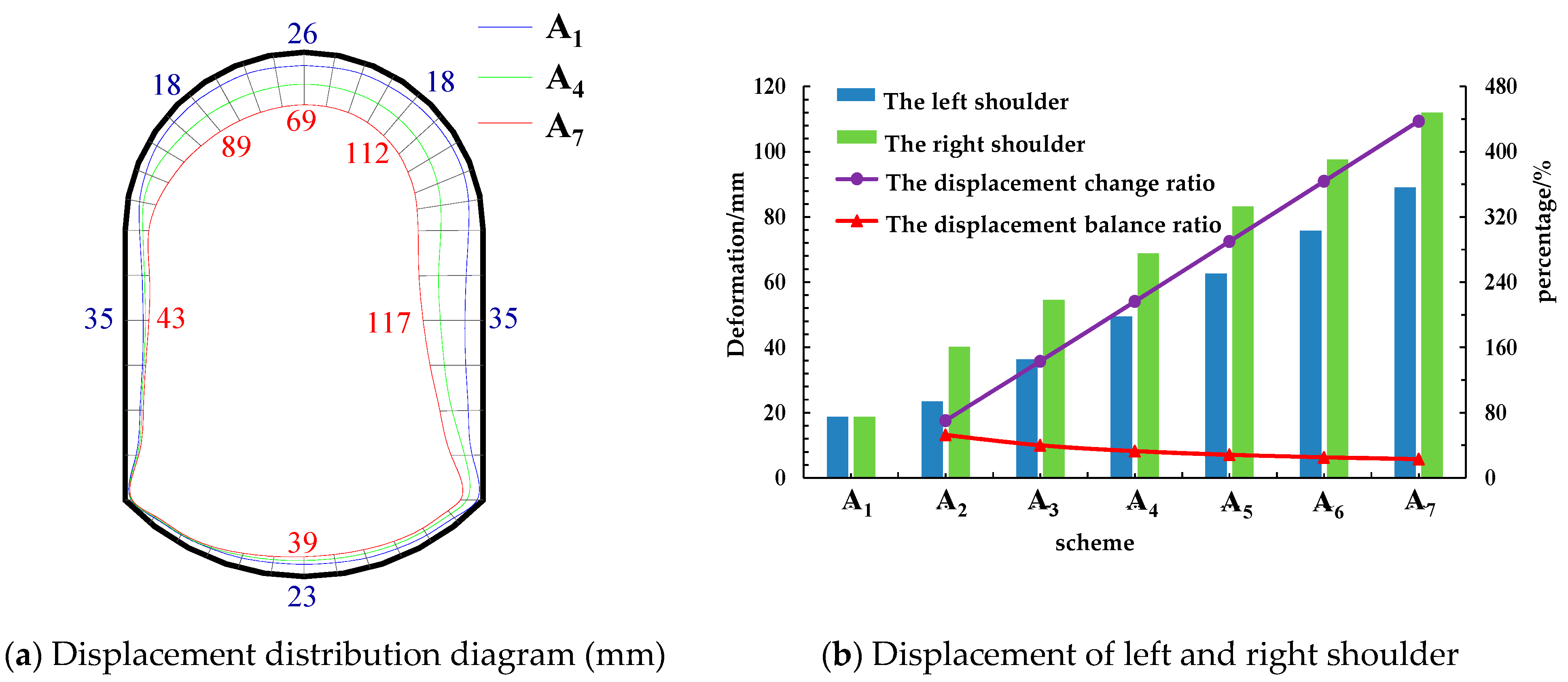
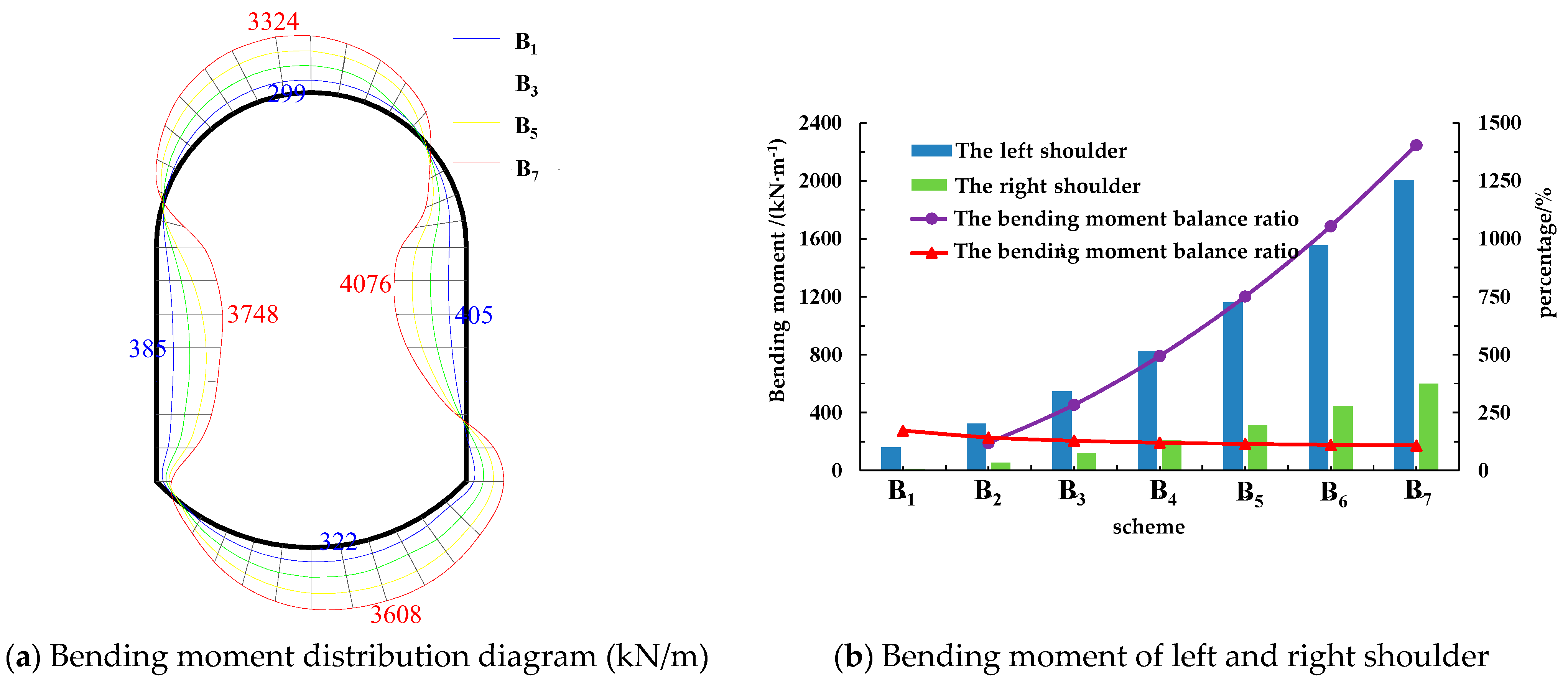
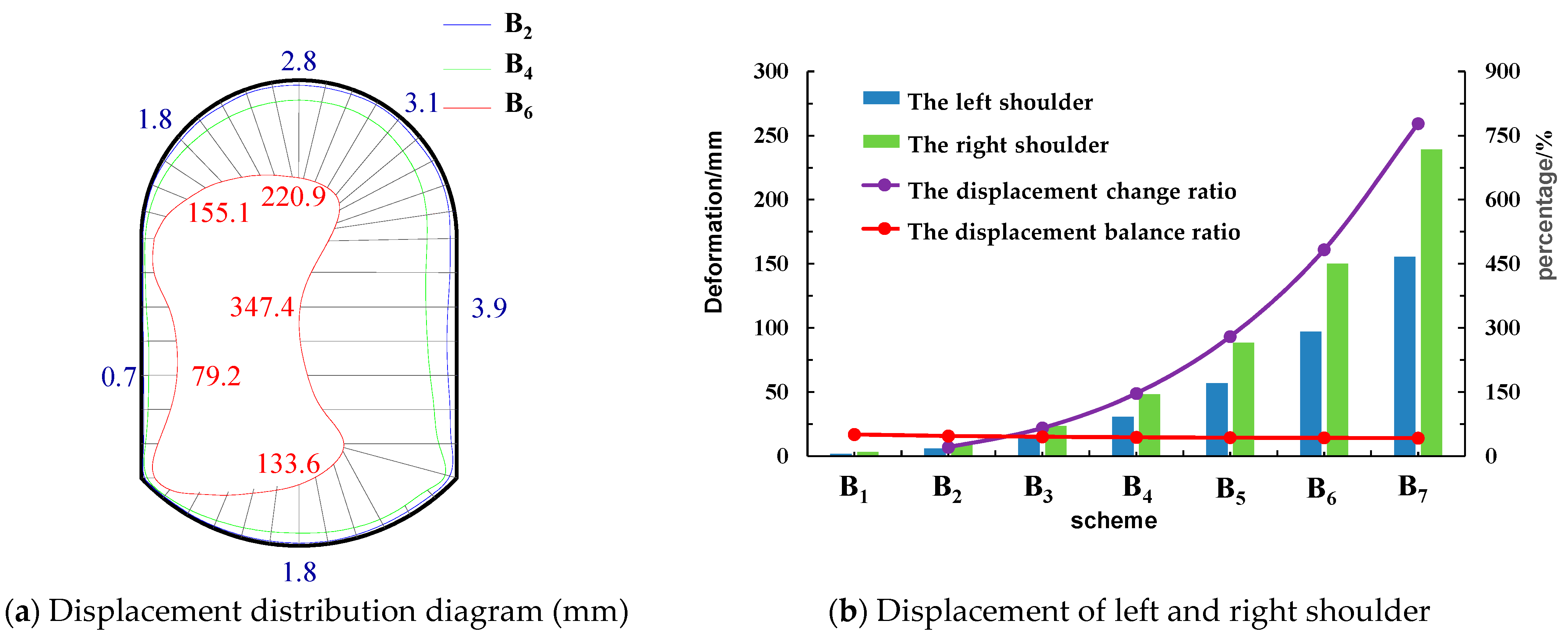
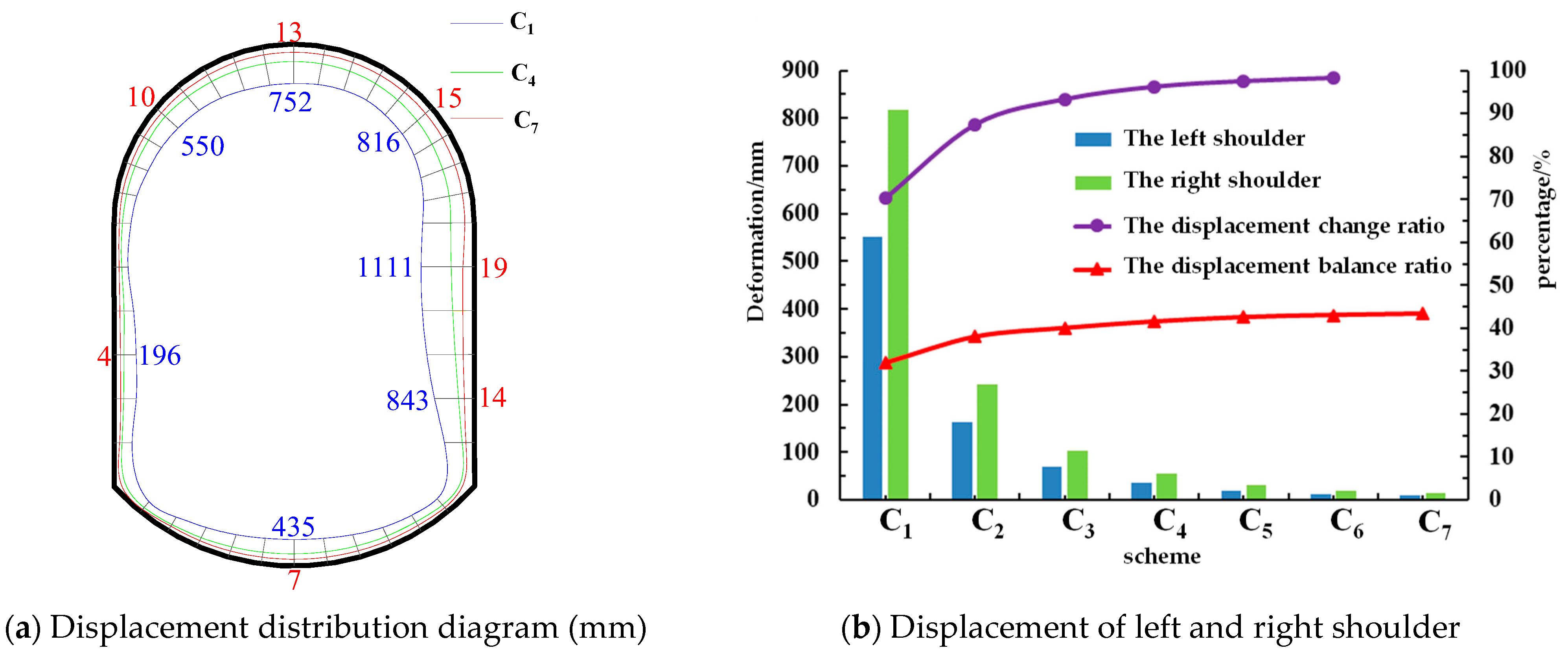
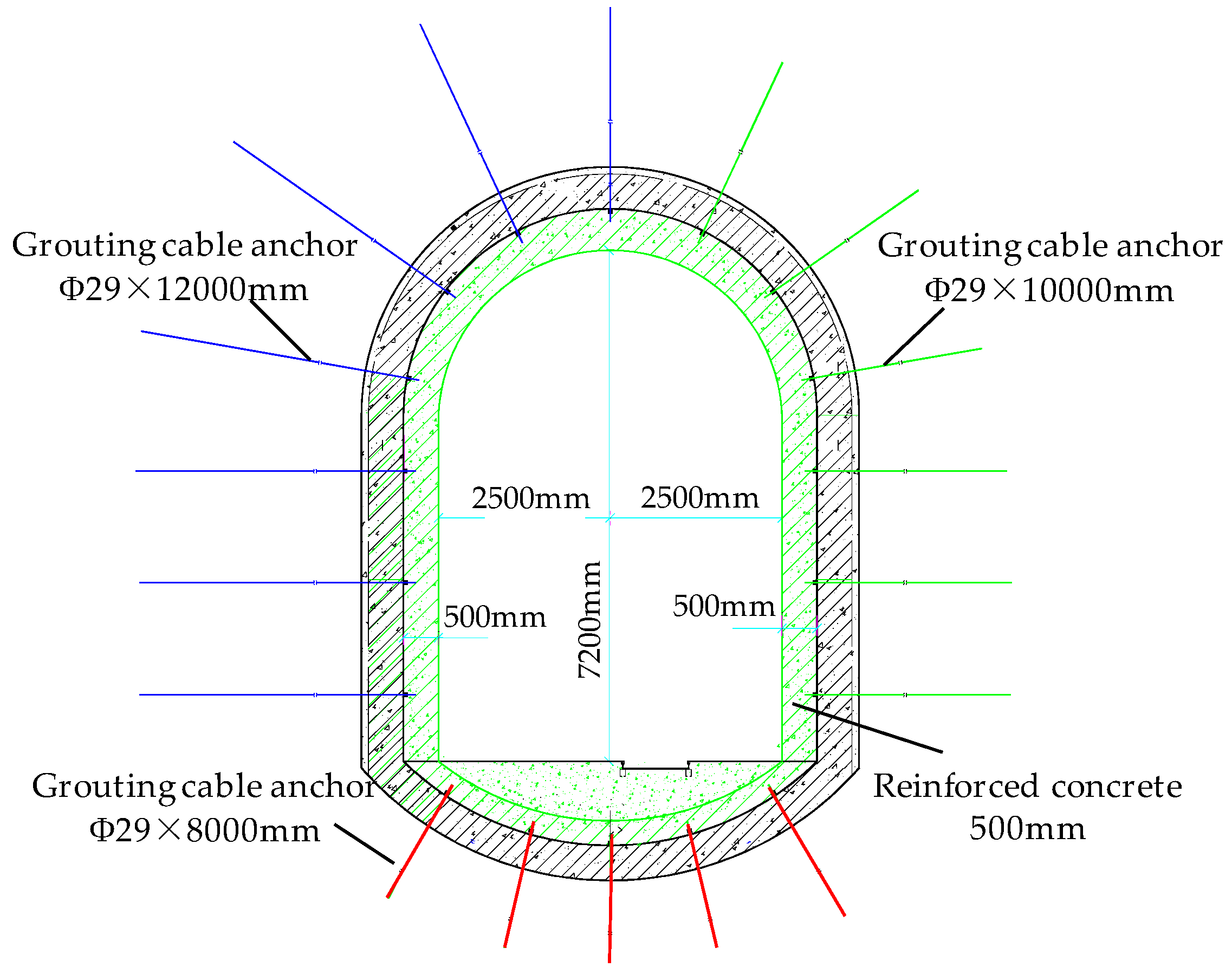


| Scheme No./Ai | Asymmetric Coefficient/λ | Invariant |
|---|---|---|
| A1 | 1 | q1, q2, q3 h, r1, r2 d |
| A2 | 1.1 | |
| A3 | 1.2 | |
| A4 | 1.3 | |
| A5 | 1.4 | |
| A6 | 1.5 | |
| A7 | 1.6 |
| Scheme No./Bi | Section Size | Invariant | ||
|---|---|---|---|---|
| Arch Crown Radius/r1 | Wall Height/h | Arch Bottom Radius/r2 | ||
| B1 | 4.0 | 2.3 | 0.2 | q1, q2, q3 d λ |
| B2 | 5.0 | 3.3 | 0.3 | |
| B3 | 6.0 | 4.3 | 0.4 | |
| B4 | 7.0 | 5.3 | 0.5 | |
| B5 | 8.0 | 6.3 | 0.6 | |
| B6 | 9.0 | 7.3 | 0.7 | |
| B7 | 10.0 | 8.3 | 0.8 | |
| Scheme No./Ci | Thickness/m | Invariant |
|---|---|---|
| C1 | 0.2 | q1, q2, q3 h, r1, r2 λ |
| C2 | 0.3 | |
| C3 | 0.4 | |
| C4 | 0.5 | |
| C5 | 0.6 | |
| C6 | 0.7 | |
| C7 | 0.8 |
Publisher’s Note: MDPI stays neutral with regard to jurisdictional claims in published maps and institutional affiliations. |
© 2021 by the authors. Licensee MDPI, Basel, Switzerland. This article is an open access article distributed under the terms and conditions of the Creative Commons Attribution (CC BY) license (https://creativecommons.org/licenses/by/4.0/).
Share and Cite
Huang, Y.; Jiang, B.; Ma, Y.; Wei, H.; Zang, J.; Gao, X. Study on Asymmetric Failure and Control Measures of Lining in Deep Large Section Chamber. Energies 2021, 14, 4075. https://doi.org/10.3390/en14144075
Huang Y, Jiang B, Ma Y, Wei H, Zang J, Gao X. Study on Asymmetric Failure and Control Measures of Lining in Deep Large Section Chamber. Energies. 2021; 14(14):4075. https://doi.org/10.3390/en14144075
Chicago/Turabian StyleHuang, Yubing, Bei Jiang, Yukun Ma, Huayong Wei, Jincheng Zang, and Xiang Gao. 2021. "Study on Asymmetric Failure and Control Measures of Lining in Deep Large Section Chamber" Energies 14, no. 14: 4075. https://doi.org/10.3390/en14144075
APA StyleHuang, Y., Jiang, B., Ma, Y., Wei, H., Zang, J., & Gao, X. (2021). Study on Asymmetric Failure and Control Measures of Lining in Deep Large Section Chamber. Energies, 14(14), 4075. https://doi.org/10.3390/en14144075





